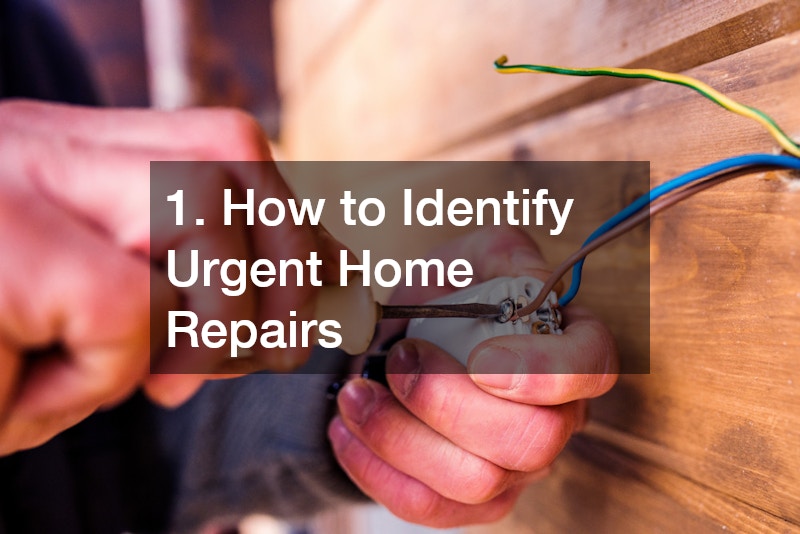Homeownership brings a sense of pride and comfort—but it also comes with an ongoing list of repairs and maintenance tasks. Over time, even the most well-kept homes begin to show signs of wear, from leaky faucets to cracked walls or aging appliances. Many homeowners worry that addressing these issues will lead to major expenses, but that doesn’t always have to be the case. With a practical approach, strategic planning, and some resourcefulness, you can handle most home repairs without draining your wallet.
In this article, we will explore cost-effective methods for managing home repairs. Whether you are dealing with urgent fixes or long-overdue updates, these tips will help you carry out repairs without overspending. By identifying which projects require immediate attention, knowing when to call a professional, and understanding how to find affordable materials, you can extend the life of your home while keeping expenses under control. The goal is to make smart decisions—not just cheap ones—that protect your property’s value and prevent small problems from turning into costly emergencies.
Affordable home repair isn’t just about cutting costs; it’s about investing wisely. Tackling preventive maintenance, for example, can save hundreds or even thousands in the long run. Keeping up with minor issues like slow drains, worn-out seals, or small leaks ensures your systems run smoothly and reduces the need for major replacements. Additionally, exploring local repair companies, comparing quotes, and learning basic DIY skills can further stretch your budget.
As we look at different aspects of your home—from plumbing and roofing to flooring and appliance upkeep—you’ll find that affordable solutions are often within reach. Let’s examine each area in detail and uncover how simple, cost-conscious steps can make a big difference in your home’s functionality and longevity.
1. How to Identify Urgent Home Repairs

Before you start any home project, it’s essential to know which repairs need immediate attention. Urgent issues usually involve water leaks, electrical hazards, or anything that poses a safety risk. For example, clogged drains can lead to water damage or even structural problems if not addressed quickly. Scheduling regular drain cleaning can prevent buildup that leads to slow drainage or pipe corrosion. Look for warning signs such as damp spots, unusual odors, or fluctuating water pressure—these are often early indicators of hidden problems. Prioritizing urgent repairs helps you allocate your budget efficiently and avoid more expensive fixes down the line.
One of the most effective ways to identify urgent repairs is by performing routine home inspections. Take time each season to walk around your home and check for leaks, cracks, or discoloration on walls and ceilings. These signs often indicate water intrusion or mold growth, both of which can worsen quickly if ignored. Additionally, pay close attention to your foundation and exterior. Uneven floors or gaps around doors and windows can suggest shifting or settling that may need professional evaluation.
It’s also wise to listen for subtle cues—dripping sounds behind walls, buzzing from electrical outlets, or sudden changes in appliance performance. These symptoms can reveal plumbing or wiring issues that, left unattended, could lead to serious damage. Keep a maintenance checklist and document each problem’s severity and urgency. This organized approach helps you plan repairs in order of importance, focusing first on those that protect safety, structural integrity, and essential utilities. Finally, don’t hesitate to call in professionals for an inspection if you’re uncertain. Early detection from an experienced eye can prevent emergencies, saving you significant costs and stress over time.
2. What Are Budget-Friendly Plumbing Fixes?
Plumbing issues can escalate quickly if ignored, but that doesn’t mean every solution has to come with a hefty price tag. Leaky faucets, running toilets, or clogged sinks are often manageable with basic tools and affordable replacement parts. However, when it comes to water quality, consider consulting a water treatment company. They can recommend affordable filtration or softening systems that extend the life of your pipes and appliances. Regular maintenance—like tightening fittings or replacing worn washers—can prevent leaks and water waste, which in turn saves on utility bills. Another effective way to manage plumbing costs is through prevention. Small habits, such as avoiding pouring grease or coffee grounds down the drain, can help keep pipes clear. Using drain screens and regularly flushing hot water through sinks helps reduce buildup and blockages. For older homes, consider scheduling annual plumbing inspections to identify corrosion or weak points before they cause leaks. These small preventive actions often eliminate the need for costly emergency calls.
Upgrading outdated fixtures can also lead to long-term savings. Modern faucets, showerheads, and toilets are designed to conserve water without sacrificing performance. Over time, this reduces both your water consumption and your bills. In addition, working with a water treatment company to test your home’s water hardness or pH levels can reveal hidden issues that contribute to mineral buildup or corrosion inside pipes. Finally, homeowners should familiarize themselves with the main water shut-off valve. Knowing how to turn off the water supply quickly can minimize damage in case of sudden leaks or burst pipes—an essential step in keeping repair expenses manageable.
3. How Can I Save on Electrical Repairs?
Electrical repairs can be intimidating, but some issues can be resolved cost-effectively with preventive care. Replacing worn-out outlets, switching to LED bulbs, or adding surge protectors are small steps that can save energy and money. Always prioritize safety—if a repair involves wiring or circuit boards, hire a licensed electrician. However, you can still manage related upkeep, like maintaining exterior lighting or ensuring proper drainage with gutter repair, which prevents water intrusion that can affect wiring or fixtures. Simple, consistent care minimizes risks and extends the life of your home’s electrical systems.
Homeowners can also take advantage of modern energy-efficient technology to reduce electrical strain. Smart thermostats, motion-sensor lights, and power strips with automatic shut-offs help lower electricity usage while improving convenience. Periodically testing circuit breakers and smoke detectors ensures your electrical system remains reliable and safe. It’s also a good idea to label your breaker panel clearly so you can quickly shut off power during repairs or emergencies. Another practical approach is to inspect outlets and cords regularly for discoloration, heat, or frayed wires—early signs of electrical wear. Installing weatherproof covers for outdoor outlets can protect them from moisture damage, while using surge protectors safeguards sensitive electronics from power fluctuations.
When planning larger projects, such as adding new appliances or lighting, consult with an electrician to verify your home’s current electrical capacity. Upgrading panels or circuits as needed can prevent overloads and reduce long-term repair costs. Preventive maintenance and awareness go a long way in keeping your home’s electrical system efficient, safe, and affordable to maintain.
4. What Are Cost-Effective Roofing Solutions?

A sturdy roof is critical to protecting your home, but repairs or replacements can be expensive if delayed. Routine inspections help you catch issues like missing shingles or small leaks before they worsen. Many homeowners now rely on air conditioning repair service providers who also perform attic and ventilation checks, ensuring both roof and HVAC systems work efficiently. Reflective coatings, sealants, and minor patchwork can restore roof integrity at a fraction of the cost of full replacement. Keeping gutters clear and checking flashing after storms are simple, affordable habits that prevent significant water damage.
5. How to Deal With Wall and Ceiling Repairs
Cracks, stains, and peeling paint on walls or ceilings are often cosmetic issues but can indicate underlying moisture or structural problems. Start by locating the source—leaks, poor insulation, or roof damage are common culprits. Patching drywall or repainting with moisture-resistant products is inexpensive and improves your home’s appearance instantly. If you notice sagging panels or mechanical noise above, don’t overlook it—it could be linked to garage structures. Scheduling garage door repair not only restores functionality but also eliminates vibration damage that can affect nearby walls. Addressing these issues promptly helps maintain your home’s integrity and aesthetics.
6. What Are the Best Ways to Improve Windows and Doors?
Windows and doors play a big role in your home’s energy efficiency. Drafty seals, loose hinges, and outdated frames can lead to higher heating and cooling costs. Instead of replacing everything, start with small upgrades like adding weather stripping or caulking gaps. For mechanical issues, a professional inspection ensures safety and longevity. If your home’s heating system is struggling to maintain comfort, you may also want to look into furnace repair services. Maintaining proper insulation and ventilation around windows and doors reduces strain on your HVAC system and keeps utility bills manageable.
7. How to Upgrade Flooring on a Budget

Flooring upgrades can transform your home, but they don’t have to cost a fortune. Vinyl planks, laminate, and engineered wood offer stylish alternatives to solid hardwood at lower prices. You can also refresh existing floors with sanding, staining, or deep cleaning instead of full replacement. If water damage has affected your floors, look into sewer line repairs or moisture control before installing new materials. Addressing root causes ensures your investment lasts. In high-traffic areas, using rugs or protective mats can further extend your flooring’s lifespan while adding warmth and personality to the space.
8. How Can I Enhance My Home’s Interior Design Affordably?
Interior design improvements don’t always require expensive remodels. Simple changes—like rearranging furniture, adding fresh paint, or updating lighting—can completely transform a room. Choose neutral color palettes for versatility, then use accent pieces to add character. If your home includes recreational spaces, regular pool repair and maintenance help sustain aesthetic appeal while keeping water systems efficient. Additionally, incorporating plants, mirrors, or DIY artwork adds charm at minimal cost. The goal is to balance comfort and creativity, proving that beautiful interiors don’t always demand a large budget.
9. What Are Some Inexpensive Exterior House Improvements?
Your home’s exterior is the first impression visitors and buyers see, and it doesn’t take much to refresh it affordably. Start with small upgrades like power washing driveways, trimming landscaping, and repainting trim or shutters. Fixing minor damage early can prevent more costly repairs later. Routine roof repairs, for instance, keep your structure weatherproof and energy-efficient. Consider updating exterior lighting or adding low-maintenance landscaping features like gravel paths or potted plants. Even a small investment in your outdoor spaces can enhance curb appeal and boost your home’s overall value.
10. How to Maintain Home Appliances Cost-Effectively?

Appliances are essential to daily living, so keeping them in good shape saves both time and money. Regular cleaning and servicing prevent mechanical wear and reduce energy consumption. For water-based appliances, periodic water heater repairs can extend lifespan and maintain performance. Cleaning refrigerator coils, replacing air filters, and checking seals on washers or dryers also contribute to efficiency. Whenever possible, consult manufacturer manuals for maintenance schedules or hire professionals for annual tune-ups. Preventive care minimizes unexpected breakdowns and helps you avoid the high cost of replacement.
Repairing Your Home With a Budget
By applying these affordable home repair strategies, you can manage your home maintenance efficiently and keep your expenses under control. Remember, a little knowledge and effort can go a long way in preserving the value and comfort of your home. The key is to stay proactive—addressing small issues before they escalate into major problems.
Regular upkeep of essentials like plumbing, roofing, and appliances creates a safer, more energy-efficient home. Routine drain cleaning prevents clogs that could lead to water damage, while timely furnace repair and air conditioning repair service appointments improve comfort and lower utility bills. When working on visible upgrades, such as flooring, windows, or walls, don’t overlook the hidden systems that make them last—like sewer line repairs, insulation, and ventilation improvements.
It’s also worth building relationships with trusted professionals. Partnering with a reliable water treatment company or scheduling consistent roof repairs ensures long-term protection for your property. Investing in preventive maintenance doesn’t just save money; it increases your home’s lifespan and resale value.
Ultimately, every homeowner can benefit from a balanced approach that combines DIY efforts with professional expertise. With smart planning, cost-conscious materials, and regular maintenance, your home can remain comfortable, functional, and beautiful for years to come—without breaking the bank.


